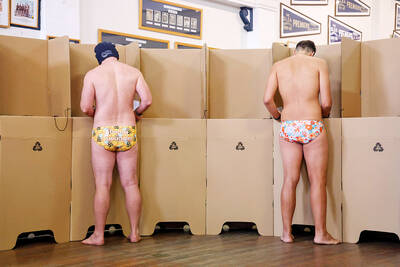American students, even in low-performing states like Alabama, do better on math and science tests than students in most foreign countries, including Italy and Norway, according to a new study released on Tuesday.
However, students in Singapore and several other Asian countries significantly outperform US students, even those in high-achieving states like Massachusetts, the study found.
"In this case, the bad news trumps the good, because our Asian economic competitors are winning the race to prepare students in math and science," said the study's author, Gary Phillips, chief scientist at the American Institutes of Research, a nonprofit independent scientific research firm.
The study equated standardized test scores of eighth-grade students in each of the 50 states with those of their peers in 45 countries. Experts said it was the first such effort to link standardized test scores, state by state, with scores from other nations.
Gage Kingsbury, a director at the Northwest Evaluation Association, a group in Oregon that carries out testing in 1,500 school districts, praised the study's methodology but said "a flock of difficulties" made it hazardous to compare test results from one country to another and from one state to another. "Kids don't start school at the same age in different countries," he said. "Not all kids are in school in grade eight, and the percentage differs from country to country."
Because of such differences, Kingsbury said, it would be a mistake to infer too much about the relative rigor of the educational systems across the states and nations in the study based merely on test score differences.
The scores for students in the US came from tests administered by the federal Department of Education in most states in 2005 and this year. For foreign students, the scores came from math and science tests administered worldwide in 2003, as part of the Trends in International Mathematics and Science Study, known as the TIMSS.
Concern that science and math achievement was not keeping pace with the nation's economic competitors had been building even before the most recent TIMSS survey, in which the highest-performing nations were Singapore, Taiwan, South Korea, Hong Kong and Japan. US students lagged far behind those nations, but earned scores that were comparable to peers in European nations like Slovakia and Estonia, and were well above countries like Egypt, Chile and Saudi Arabia.
The TIMSS survey gives each country a metric by which to compare its educational attainment with other nations. The US nationwide test, known as the National Assessments of Educational Progress, allows policymakers in each state to compare their students' results with those in other states.
The new study used statistical linking to compare scores on the national assessment, state by state, with other nations' scores on the TIMSS. Phillips, who from 1999 to 2002 led the agency of the Department of Education that administers the national assessment, likened the methodology to what economists do when they convert international currencies into dollars to compare poverty levels across various countries, for instance.
On the most recent national assessment, the highest-performing state in math was Massachusetts, and in science, North Dakota. The new study shows that average math achievement in Massachusetts was lower than in the leading Asian nations and in Belgium, but higher than in 40 other countries, including Australia, Russia, England and Israel.
Mississippi was the lowest-performing state in both math and science. In math, Mississippi students' achievement was compar-able to those of peers in Bulgaria and Moldova, and in science, to those in Norway and Romania.
In math, New Jersey, Connecticut and New York students were roughly equivalent with each other and with their peers in Australia, the Netherlands and Hungary.
The study's contribution is the high-level perspective it offers on the nation's education system, a bit the way a satellite image highlights the nation's topography, said Thomas Toch, a co-director of Education Sector, an independent policy group.
"It shows we're not doing as badly as some say," Toch said. "We're in the top half of the table, and a number of states are outperforming the majority of nations in the study. But our performance in math and science lags behind that of the front-running Asian nations."

Kehinde Sanni spends his days smoothing out dents and repainting scratched bumpers in a modest autobody shop in Lagos. He has never left Nigeria, yet he speaks glowingly of Burkina Faso military leader Ibrahim Traore. “Nigeria needs someone like Ibrahim Traore of Burkina Faso. He is doing well for his country,” Sanni said. His admiration is shaped by a steady stream of viral videos, memes and social media posts — many misleading or outright false — portraying Traore as a fearless reformer who defied Western powers and reclaimed his country’s dignity. The Burkinabe strongman swept into power following a coup in September 2022

‘FRAGMENTING’: British politics have for a long time been dominated by the Labor Party and the Tories, but polls suggest that Reform now poses a significant challenge Hard-right upstarts Reform UK snatched a parliamentary seat from British Prime Minister Keir Starmer’s Labor Party yesterday in local elections that dealt a blow to the UK’s two establishment parties. Reform, led by anti-immigrant firebrand Nigel Farage, won the by-election in Runcorn and Helsby in northwest England by just six votes, as it picked up gains in other localities, including one mayoralty. The group’s strong showing continues momentum it built up at last year’s general election and appears to confirm a trend that the UK is entering an era of multi-party politics. “For the movement, for the party it’s a very, very big

ENTERTAINMENT: Rio officials have a history of organizing massive concerts on Copacabana Beach, with Madonna’s show drawing about 1.6 million fans last year Lady Gaga on Saturday night gave a free concert in front of 2 million fans who poured onto Copacabana Beach in Rio de Janeiro for the biggest show of her career. “Tonight, we’re making history... Thank you for making history with me,” Lady Gaga told a screaming crowd. The Mother Monster, as she is known, started the show at about 10:10pm local time with her 2011 song Bloody Mary. Cries of joy rose from the tightly packed fans who sang and danced shoulder-to-shoulder on the vast stretch of sand. Concert organizers said 2.1 million people attended the show. Lady Gaga

SUPPORT: The Australian prime minister promised to back Kyiv against Russia’s invasion, saying: ‘That’s my government’s position. It was yesterday. It still is’ Left-leaning Australian Prime Minister Anthony Albanese yesterday basked in his landslide election win, promising a “disciplined, orderly” government to confront cost-of-living pain and tariff turmoil. People clapped as the 62-year-old and his fiancee, Jodie Haydon, who visited his old inner Sydney haunt, Cafe Italia, surrounded by a crowd of jostling photographers and journalists. Albanese’s Labor Party is on course to win at least 83 seats in the 150-member parliament, partial results showed. Opposition leader Peter Dutton’s conservative Liberal-National coalition had just 38 seats, and other parties 12. Another 17 seats were still in doubt. “We will be a disciplined, orderly